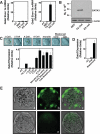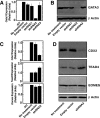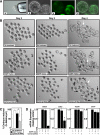GATA3 is selectively expressed in the trophectoderm of peri-implantation embryo and directly regulates Cdx2 gene expression
- PMID: 19700764
- PMCID: PMC2781418
- DOI: 10.1074/jbc.M109.016840
GATA3 is selectively expressed in the trophectoderm of peri-implantation embryo and directly regulates Cdx2 gene expression
Abstract
During early mammalian development, genesis of the first two cell lineages, inner cell mass (ICM) and trophectoderm (TE), is dependent upon functions of key transcription factors that are expressed in a regulated and spatially restricted fashion. In this study, we demonstrate that during early mouse development, mRNA expression of transcription factor GATA3 is induced at the 4-cell stage and is consistently present during pre-implantation embryonic development. Interestingly, at the blastocyst stage, Gata3 mRNA is selectively up-regulated within the TE lineage, and GATA3 protein is abundantly present only in the TE but not in the ICM. Using mouse trophoblast stem cells (TS cells) as a model, we found that, knockdown of GATA3 by RNA interference (RNAi) down-regulates expression of caudal-type homeobox 2 (CDX2), a key regulator of the TE lineage. Chromatin immunoprecipitation (ChIP) analyses revealed that, in TS cells, GATA3 directly regulates Cdx2 transcription from a conserved GATA motif at the intron 1 region of the Cdx2 locus. ChIP analyses with mouse blastocysts also detected GATA3 occupancy at intron 1 of the Cdx2 locus. In addition, down-regulation of GATA3 in pre-implantation mouse embryos reduces Cdx2 expression and inhibits morula to blastocyst transformation. Our results indicate a novel function of GATA3, in which it is selectively expressed in TE, regulates expression of key genes in TE lineage, and is involved in morula to blastocyst transformation.
Figures




Similar articles
-
TEAD4 regulates trophectoderm differentiation upstream of CDX2 in a GATA3-independent manner in the human preimplantation embryo.Hum Reprod. 2022 Jul 30;37(8):1760-1773. doi: 10.1093/humrep/deac138. Hum Reprod. 2022. PMID: 35700449
-
Changes in the expression patterns of the genes involved in the segregation and function of inner cell mass and trophectoderm lineages during porcine preimplantation development.J Reprod Dev. 2013;59(2):151-8. doi: 10.1262/jrd.2012-122. Epub 2012 Dec 20. J Reprod Dev. 2013. PMID: 23257836 Free PMC article.
-
EED and KDM6B coordinate the first mammalian cell lineage commitment to ensure embryo implantation.Mol Cell Biol. 2013 Jul;33(14):2691-705. doi: 10.1128/MCB.00069-13. Epub 2013 May 13. Mol Cell Biol. 2013. PMID: 23671187 Free PMC article.
-
Mechanisms of trophectoderm fate specification in preimplantation mouse development.Dev Growth Differ. 2010 Apr;52(3):263-73. doi: 10.1111/j.1440-169X.2009.01158.x. Epub 2010 Jan 20. Dev Growth Differ. 2010. PMID: 20100249 Review.
-
Trophoblast lineage specification in the mammalian preimplantation embryo.Reprod Med Biol. 2020 Jul 2;19(3):209-221. doi: 10.1002/rmb2.12333. eCollection 2020 Jul. Reprod Med Biol. 2020. PMID: 32684820 Free PMC article. Review.
Cited by
-
scRCMF: Identification of Cell Subpopulations and Transition States From Single-Cell Transcriptomes.IEEE Trans Biomed Eng. 2020 May;67(5):1418-1428. doi: 10.1109/TBME.2019.2937228. Epub 2019 Aug 23. IEEE Trans Biomed Eng. 2020. PMID: 31449003 Free PMC article.
-
Klf5 regulates lineage formation in the pre-implantation mouse embryo.Development. 2010 Dec;137(23):3953-63. doi: 10.1242/dev.054775. Epub 2010 Oct 27. Development. 2010. PMID: 20980403 Free PMC article.
-
Evaluating totipotency using criteria of increasing stringency.Nat Cell Biol. 2021 Jan;23(1):49-60. doi: 10.1038/s41556-020-00609-2. Epub 2021 Jan 8. Nat Cell Biol. 2021. PMID: 33420491
-
Multi-omics analysis of uterine fluid extracellular vesicles reveals a resemblance with endometrial tissue across the menstrual cycle: biological and translational insights.Hum Reprod Open. 2025 Feb 24;2025(2):hoaf010. doi: 10.1093/hropen/hoaf010. eCollection 2025. Hum Reprod Open. 2025. PMID: 40084293 Free PMC article.
-
Bmi1 facilitates primitive endoderm formation by stabilizing Gata6 during early mouse development.Genes Dev. 2012 Jul 1;26(13):1445-58. doi: 10.1101/gad.188193.112. Epub 2012 Jun 19. Genes Dev. 2012. PMID: 22713603 Free PMC article.
References
-
- Rossant J. (2004) Semin. Cell Dev. Biol. 15, 573–581 - PubMed
-
- Zernicka-Goetz M. (2005) Nat. Rev. Mol. Cell Biol. 6, 919–928 - PubMed
-
- Kunath T., Strumpf D., Rossant J. (2004) Placenta 25, Suppl. A, S32–S38 - PubMed
-
- Chawengsaksophak K., James R., Hammond V. E., Köntgen F., Beck F. (1997) Nature 386, 84–87 - PubMed
-
- Strumpf D., Mao C. A., Yamanaka Y., Ralston A., Chawengsaksophak K., Beck F., Rossant J. (2005) Development 132, 2093–2102 - PubMed
Publication types
MeSH terms
Substances
Grants and funding
LinkOut - more resources
Full Text Sources
Molecular Biology Databases
Research Materials

